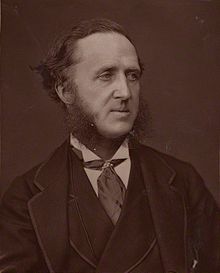Dudley Ryder, 3rd Earl of Harrowby
|
The Right Honourable The Earl of Harrowby PC JP DL |
|
|---|---|
 |
|
| President of the Board of Trade | |
|
In office 4 April 1878 – 21 April 1880 |
|
| Monarch | Victoria |
| Prime Minister | The Earl of Beaconsfield |
| Preceded by | Sir Charles Adderley |
| Succeeded by | Joseph Chamberlain |
| Personal details | |
| Born |
16 January 1831 Brighton |
| Died | 26 March 1900 (aged 69) Sandon Hall, Staffordshire |
| Nationality | British |
| Political party | Conservative |
| Spouse(s) | Lady Mary Cecil (d. 1917) |
| Alma mater | Christ Church, Oxford |
Dudley Francis Stuart Ryder, 3rd Earl of Harrowby PC JP DL (16 January 1831 – 26 March 1900), known as Viscount Sandon from 1847 to 1882, was a British peer and politician.
He was the second son and eventual heir of Dudley Ryder, 2nd Earl of Harrowby, and Lady Frances Stuart, fourth daughter of John, first marquis of Bute. He was born at Brighton on 16 January 1831. He was educated at Harrow and the university of Oxford, where he matriculated from Christ Church on 31 May 1849, graduated B.A. in 1853, and proceeded M.A. in 1878.
On leaving the university, Viscount Sandon, as he was styled during his father's lifetime, made a tour in the East with Lord Carnarvon, visiting Syria and the Lebanon (see Carnavon's Recollections of the Druses of the Lebanon, London, 1860, 8vo). On his return to England, he did garrison duty as captain in the 2nd Staffordshire militia regiment, during the Crimean war and Indian mutiny.
Harrowby was Member of Parliament (MP) for Lichfield from 1856 to 1859 and for Liverpool from 1868 until he succeeded to the peerage in 1882. He gained experience of affairs as private secretary to Henry Labouchere at the colonial office.
He was a member of the select committees on the Hudson's Bay Company (1857) and the Euphrates Valley (1871-2), and continued throughout life to devote much time and attention to the study of imperial and colonial questions. He was Vice-President of the Committee on Education from 1874 to 1878, and President of the Board of Trade (with a seat in the cabinet) from 1878 to 1880 in Benjamin Disraeli's second administration and was sworn of the Privy Council in 1874. Between 1885 and 1886, he served as Lord Privy Seal in Lord Salisbury's first government.
...
Wikipedia
